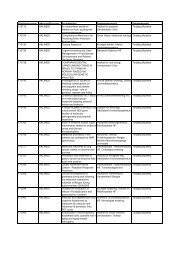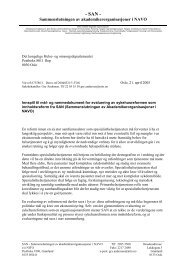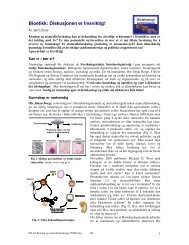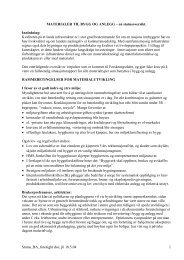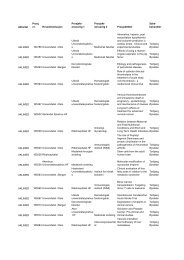A Revolution in R&D
A Revolution in R&D
A Revolution in R&D
Create successful ePaper yourself
Turn your PDF publications into a flip-book with our unique Google optimized e-Paper software.
R&D decisions alone. Almost certa<strong>in</strong>ly, the decisions<br />
were thrashed out at the corporate level.<br />
For more modest-sized companies, strategic choices<br />
often go beyond matters of preference or emphasis.<br />
The question might be whether to concentrate all<br />
their efforts on some value cha<strong>in</strong> steps and forgo<br />
others altogether. Certa<strong>in</strong>ly it no longer makes<br />
sense for even midsized pharmaceutical companies<br />
to compete <strong>in</strong> target identification. And at the<br />
smaller end of the scale, companies with less than<br />
$400 million <strong>in</strong> R&D, say, may f<strong>in</strong>d themselves ask<strong>in</strong>g<br />
even more radical questions: Can we afford<br />
research at all? Should we not focus exclusively on<br />
licens<strong>in</strong>g <strong>in</strong>stead? Aga<strong>in</strong>, it is at the corporate level,<br />
rather than with<strong>in</strong> R&D alone, that such questions<br />
will eventually be settled.<br />
It is not just through major partnerships and<br />
<strong>in</strong>vestment decisions, however, that the corporate<br />
level is imp<strong>in</strong>g<strong>in</strong>g on R&D strategy. More and more,<br />
specific R&D activities are hav<strong>in</strong>g ramifications<br />
beyond R&D itself, and <strong>in</strong>vok<strong>in</strong>g corporate-level<br />
participation. Pharmacogenetics, for <strong>in</strong>stance,<br />
often touches on corporate strategy as much as on<br />
R&D strategy. Should the company cont<strong>in</strong>ue to pursue<br />
a promis<strong>in</strong>g compound, say, when the risk of<br />
market fragmentation might outweigh the positive<br />
market effects? Should the company attempt to resurrect<br />
candidate drugs previously killed because of<br />
rare side effects? And so on.<br />
R&D Leadership Decisions:<br />
Where and How to Compete<br />
With genomics and genetics now part of the landscape,<br />
R&D decision mak<strong>in</strong>g has become more<br />
complex. The options are far more numerous:<br />
there are more ways of ga<strong>in</strong><strong>in</strong>g access to capabilities,<br />
more technologies to choose among, and even<br />
new dimensions <strong>in</strong> which to compete. R&D executives<br />
must select a comb<strong>in</strong>ation of options that not<br />
only dovetail with the company’s start<strong>in</strong>g position<br />
and aspirations but can also be <strong>in</strong>tegrated smoothly<br />
with one another.<br />
Choos<strong>in</strong>g a Research Focus<br />
The dimensions of competition <strong>in</strong>clude:<br />
• Disease states. Some disease states have become<br />
more tractable, thanks to genomics approaches,<br />
and any company cont<strong>in</strong>u<strong>in</strong>g to <strong>in</strong>vestigate them<br />
will have to deploy genomics if it is to rema<strong>in</strong><br />
competitive. Just which therapeutic areas or disease<br />
states are most amenable to genomics is<br />
determ<strong>in</strong>ed by several factors: the degree to<br />
which the disease is genetic <strong>in</strong> nature, the current<br />
understand<strong>in</strong>g of disease processes at a molecular<br />
or genetic level, and so on.<br />
• Target class. Some genomics approaches are at<br />
odds with traditional therapeutic-area borders,<br />
and favor a broader deployment—around target<br />
class—rather than the old focus on disease state.<br />
(The targets with<strong>in</strong> a class are usually similar <strong>in</strong><br />
structure and biochemical function.)<br />
• Therapeutic modalities. Small-molecule drugs<br />
still dom<strong>in</strong>ate the market, but they no longer<br />
monopolize it. Some new therapeutic modalities<br />
have already established a foothold—<strong>in</strong>jectible<br />
prote<strong>in</strong> therapeutics, for <strong>in</strong>stance, based on<br />
secreted factors and antibodies. Others rema<strong>in</strong><br />
very much <strong>in</strong> the experimental stage—gene therapy<br />
and anti-sense techology, for example—though<br />
adventurous companies are pursu<strong>in</strong>g them<br />
undaunted (as exemplified by Lilly’s recent $200<br />
million deal with Isis to ga<strong>in</strong> access to anti-sense<br />
capabilities).<br />
These dimensions are <strong>in</strong>terconnected, of course,<br />
and even <strong>in</strong>terdependent. Take Novartis’s <strong>in</strong>terest<br />
<strong>in</strong> oncology, for example—a broad disease state.<br />
Given that <strong>in</strong>terest, it made sense for the company<br />
to focus on k<strong>in</strong>ases, a key target class <strong>in</strong> oncology.<br />
K<strong>in</strong>ases constitute one of the few target classes that<br />
are amenable to a particular genomics approach, <strong>in</strong><br />
silico drug design. Novartis has duly set about augment<strong>in</strong>g<br />
its expertise with the appropriate<br />
genomics technology, form<strong>in</strong>g an alliance with<br />
Vertex to that end.<br />
47



